One of the interest of this capability is that it also allows you to make 2D kinematics studies in the Sketcher.
This task shows you how to make two elongated holes perpendicular, then how to position them inside a rectangle, while using the Fix Together command.
Making Elongated Holes Perpendicular
Prior to using the Fix Together command, consider the following scenario: to make both elongated holes perpendicular to each other, you could be tempted to select one oblong hole then drag it next to the second one, and eventually set a perpendicular constraint. The fact is that setting the constraint if no other constraints are set, deforms the holes. To quickly achieve the desired geometry, follow the steps as explained below.
-
Click Fix Together
 .
.
From V5R17 onwards, as soon as Fix Together is selected, the Fix Together Definition dialog box is displayed even if no geometry is selected. -
Select one elongated hole by using the selection trap.
The Fix Together Definition dialog
box that appears displays all selected geometrical elements.
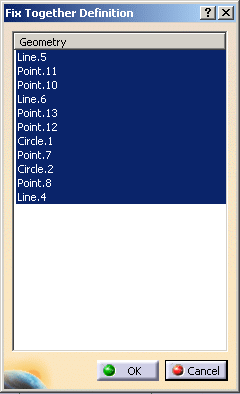
Selecting Geometrical Elements
Dependencies
To assume that the rigid body behavior can be managed, by default the application includes element dependencies. When adding a spline for instance, all its control points and control point tangencies are automatically added even if they were not selected.
The following table lists geometric elements and their corresponding
dependencies:
|
Geometric Element |
Dependency |
|
| Line | Start point + End point | |
| Circle/Ellipse | Center point | |
| Arc of Circle/Ellipse | Enter point + Start point + End point | |
| Parabola/Hyperbola | Start point + End point | |
| Conic by two points | Start point + End point + (Start Tangent curve + End Tangent curve) or Tangent Intersection point + (Passing point or Not) | |
| Conic by four points | Four points + One Tangent curve | |
| Conic by five points | Five points | |
| Connect Curve | First point + Second point + First curve + Second curve | |
| Spline | Control points + Tangent directions |
Number of Elements
You can select as many geometrical elements as you wish, but just remember that a geometrical element can be used by only one Fix Together constraint.
Whenever you wish to remove elements from the selection, just right-click the element of interest and select Delete. Alternatively, just select the element in the geometry area again.
Absolute Axis
You can select the origin, the H or V Direction of the sketch absolute axis. These three elements cannot be selected at the same time by a selection trap. You need to explicitly select them one by one.
-
Click OK to confirm.
The Fix together constraint is
created as indicated by a green paper clip symbol.
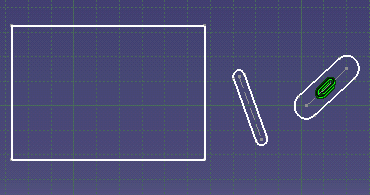
Degrees of Freedom
The set of geometric elements constrained by Fix Together has three degrees of freedom whatever the number of elements. In order to be fully defined, the set needs to be dimensioned to fix geometry taking up at least the three degrees of freedom (one rotation and two translations).
A geometric element included in a set of elements constrained via
Fix Together
![]() can also be constrained using
can also be constrained using
![]() .
If, for instance, a Fix Together constraint contains a fixed line, the set
of geometric elements has one single degree of freedom which is along the
direction of the line.
.
If, for instance, a Fix Together constraint contains a fixed line, the set
of geometric elements has one single degree of freedom which is along the
direction of the line.
-
Repeat the operation for the second elongated hole.
Just to check that you can now manipulate each hole by keeping its rigid body.
-
Select them and drag them to any location.
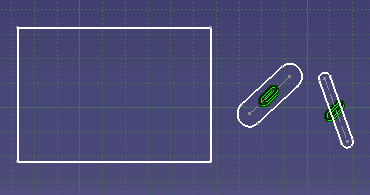
-
Set the perpendicular constraint.
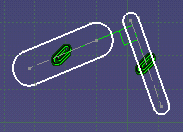
Positioning Holes in the Rectangle
-
To position both holes inside the rectangle, delete the constraints you previously set.
-
Create only one Fix Together for both holes.
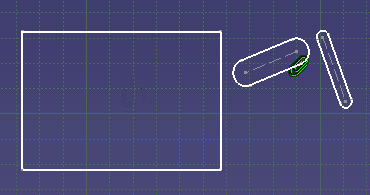
-
Drag the holes all together inside the rectangle after selecting any of their geometrical element and add constraints between the rectangle and the holes to specify their exact positions.
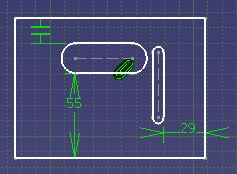
-
Select the Fix Together constraint attaching the holes and use the Fix-Together.x object > Deactivate contextual menu item.
Note that if the Fix Together constraint is deactivated, the geometric elements are always seen by the application as belonging to a rigid set. So selecting them remains impossible for defining another Fix Together constraint.
You can now modify the shapes of the holes as the constraint is deactivated. -
Enlarge the right hole.
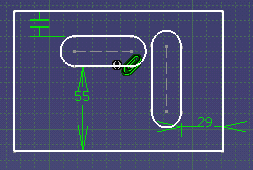
-
Note that passing the cursor over an activated or not Fix Together constraint highlights the associated geometry.
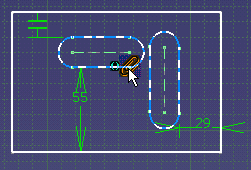
Editing a Fix Together Constraint
You can add a geometrical element to a Fix Together constraint provided it belongs to the current sketch and is not already included in another Fix Together constraint. The selection or the pre-selection of the elements to add depends on this verification during the Fix Together constraint creation and editing.
You can add several elements at the same time either by using the CTRL key or the selection trap. After a selection:
- Geometrical elements not used for the definition are added
- Geometrical elements that are already part of the definition are removed.
Additional Constraints
- Adding constraints between elements involved in a Fix Together constraint and other elements involved too in a distinct Fix Together constraint or free elements allows you to position the fixed together set.
- Adding a constraint to a fixed together element brings about an over-constrained system. But unlike other types of constraints, when exiting the Sketcher, the application does not detect no inconsistency.
- All existing or added constraints on geometric elements of a Fix Together constraints are seen as over-defined (in purple when solving status is displayed).
Except for Fix constraints, no constraints are solved between geometric elements linked by the same Fix Together constraint. However, no update error appears on such over-defined constraints (between Fixed Together geometric elements) and the part is successfully updated.
Removing Geometrical Elements
You can remove geometrical elements from a Fix Together constraint by deleting the geometrical elements: dependencies are deleted too.
When the number of geometric elements in the set is less than two, the Fix Together constraint is NOT automatically deleted.
Applying Operations Onto Fix Together Constraint
Copy/Paste
You can copy and paste a fix together set (not the constraint alone). To do so:
-
Select the paper clip.
-
Use the Fix Together object > Select Geometrical Elements contextual menu item.
-
Use Ctrl to include the paper clip in the selection.
or
-
Use the selection trap to ensure that the paper clip and the associated constrained geometry are selected.
-
Apply the Copy > Paste capability.
Mirror
By switching off the Geometric constraints mode, the Fix
Together constraint is taken into account like the other constraints when
mirroring geometries and keeping the initial constraints:
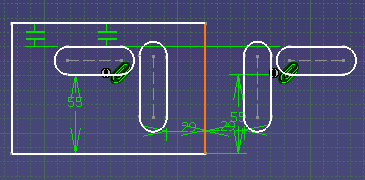
...otherwise, the application
creates symmetry constraints as requested.
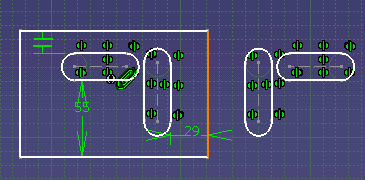
Break/Trim/Corner/Chamfer
You can apply the Break
![]() ,
Trim
,
Trim
![]() ,
Corner
,
Corner
![]() and Chamfer
and Chamfer
![]() commands onto elements attached by a fix together constraint.
commands onto elements attached by a fix together constraint.
When all the geometrical elements belong to the same Fix Together constraint, the constraint is updated accordingly. For instance, when breaking a curve, the new half curve is automatically added to the definition.
Methodology
Depending on your geometry and your needs, you will use the Fix
Together
![]() command or the the Auto Constraint command, bearing in mind that:
command or the the Auto Constraint command, bearing in mind that:
- The Fix Together
 command creates only one constraint for a group or elements.
command creates only one constraint for a group or elements. - The Auto Constraint
 command detects all possible constraints
between the selected elements then creates these constraints. This means
that sometimes you may create a lot of unnecessary constraints just for
imposing a rigid behavior. For more information, refer to Autoconstraining a Group of Elements in CATIA Sketcher User's Guide.
command detects all possible constraints
between the selected elements then creates these constraints. This means
that sometimes you may create a lot of unnecessary constraints just for
imposing a rigid behavior. For more information, refer to Autoconstraining a Group of Elements in CATIA Sketcher User's Guide.
The Fix Together
![]() command is a way of getting better solving performances as well as solving
more complex systems including rigid sub-parts.
command is a way of getting better solving performances as well as solving
more complex systems including rigid sub-parts.
|
|